

Tree of Life history and research. Celtic Tree of life and how it relates to Tree of Life Tattoos.A research, design and history page about the Tree of life thru the ages to its now modern use as a Tattoo design.. Tree of Life Tattoos, pictures, images and designs.

Tree of Life Tattooing by Captain Bret Captain Bret's Tattoo Shop Established 1980 2 Collins St. Newport, Rhode Island. We do expert Lettering and Calligraphy. Buy & Download unique custom Tattoo designs in our online store Tree of Life with Free Birds Often taken for granted and even considered to be a nuisance in today's technological age, there is an aspect to trees that we might not have even considered. Tree of Life. Kalamkari began as the temple art of Andhra Pradesh and slowly occupied an important place in the arts and crafts of India.
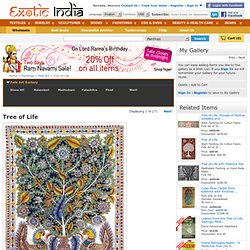
The artisan uses a pen - like brush called 'kalam', giving the technique its name. The tree is one of the most potent of symbols. Its roots delve into the underworld its trunk links the earth to the heavens - it transcends all three spheres. It symbolizes birth, maturity, death and rebirth embodied in leaf, bud and fruit. Tree of Life Gallery - Evolution.
As of July 1, 2013 ThinkQuest has been discontinued.

We would like to thank everyone for being a part of the ThinkQuest global community: Students - For your limitless creativity and innovation, which inspires us all. Teachers - For your passion in guiding students on their quest. Partners - For your unwavering support and evangelism. Parents - For supporting the use of technology not only as an instrument of learning, but as a means of creating knowledge. We encourage everyone to continue to “Think, Create and Collaborate,” unleashing the power of technology to teach, share, and inspire. Best wishes, The Oracle Education Foundation. A new tree of life. Early in Earth’s history, there existed an organism that would give rise to all the species known today.
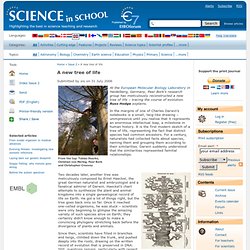
In 1994, Christos Ouzounis and Nikos Kyrpides gave this shadowy creature a name: LUCA, for the last universal common ancestor. Studies of DNA sequences taken from plants, fungi, animals, bacteria, and another form of one-celled organism called Archaea proved that it must have existed. But until recently, scientists could say very little else about it. “Two things have changed,” Peer says. “First is the immense amount of information we have from DNA sequencing – over 350 organisms have been completely sequenced, spread across the entire spectrum of life. It also allows researchers to reconstruct hypothetical ancestors. "Over the past few decades, scientists have realised there is an important exception to this rule,” Peer says. Peer says that attempts have been made to find such genes and eliminate them when building trees from DNA sequence data. Porphyrian tree.
Porphyry's Isagoge was originally written in Greek, but was translated into Latin in the early 6th century C.E. by Boethius.
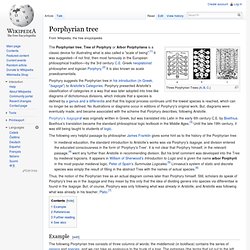
Boethius's translation became the standard philosophical logic textbook in the Middle Ages.[3] Until the late 19th century, it was still being taught to students of logic. In medieval education, the standard introduction to Aristotle's works was via Porphyry's Isagoge, and division entered the educated consciousness in the form of 'Porphyry's Tree'. It is not clear that Porphyry himself, in the relevant passage,[4] went any further than Aristotle in recommending division.
On the Origin of Species. Various evolutionary ideas had already been proposed to explain new findings in biology.

There was growing support for such ideas among dissident anatomists and the general public, but during the first half of the 19th century the English scientific establishment was closely tied to the Church of England, while science was part of natural theology. Ideas about the transmutation of species were controversial as they conflicted with the beliefs that species were unchanging parts of a designed hierarchy and that humans were unique, unrelated to other animals. The political and theological implications were intensely debated, but transmutation was not accepted by the scientific mainstream. Summary of Darwin's theory[edit] Darwin pictured shortly before publication Darwin's theory of evolution is based on key facts and the inferences drawn from them, which biologist Ernst Mayr summarised as follows:[3] Background[edit] Developments before Darwin's theory[edit]
Haeckel's "The Evolution of Man", by Alfred Russel Wallace. Alfred Russel Wallace : Alfred Wallace : A.
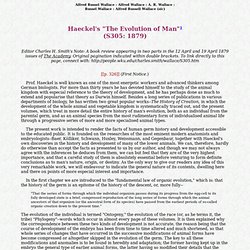
R. Wallace :Russel Wallace : Alfred Russell Wallace (sic) Haeckel's "The Evolution of Man"1 (S305: 1879) Editor Charles H. Smith's Note: A book review appearing in two parts in the 12 April and 19 April 1879 issues of The Academy. [[p. 326]] (First Notice.) Kabbalah, Qabbalah. Qabbalah - Kabbalah Tree of Life Kabbalah is an interpretation (exegesis, hermeneutic) key, "soul" of the Torah (Hebrew Bible), or the religious mystical system of Judaism claiming an insight into divine nature.
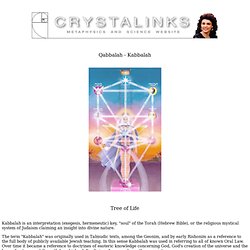
The term "Kabbalah" was originally used in Talmudic texts, among the Geonim, and by early Rishonim as a reference to the full body of publicly available Jewish teaching. Tree of Life.